Synchronization pattern
The synchronization pattern for a family defines which replicas exchange update packets and the direction of exchange.
Figure 1 in Replica synchronization in a family shows a simple synchronization pattern, involving one point-to-point update. All updates need not be point to point, however, because they are cumulative. Suppose that the following updates take place among three replicas:
Update 1: Replica 1 sends changes to Replica 2 Update 2: Replica 2 sends changes to Replica 3
There is no need for Replica 1 to update Replica 3 directly, because the changes from Update 1 are included in Update 2. This feature gives you flexibility in devising update strategies and patterns. For efficiency, a single update can be targeted at multiple replicas, for example, all other replicas in a family.


- Bandwidth between sites
- Network topology
- Latency of changes: how quickly changes made at one replica need to be received at another replica in the family
- Failure tolerance
The following topics describe unidirectional and bidirectional exchanges and the most common synchronization patterns.